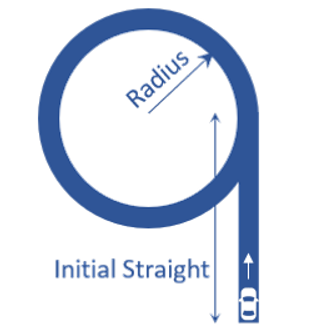Braking In a Turn
A Braking in a turn event simulates a vehicle decelerating in a circular path.
The purpose of this event is to measure the stability of a vehicle while braking and turning. The vehicle is driven straight for the entry length and then turns onto the circular path. At the "Time to Apply Brakes" time, the brake torque is ramped on using the "Brake Step Duration" time so the vehicle slows at the "Desired Deceleration" rate. The event ends at the "End of Simulation" time.
The braking in a turn event is supported by the Cars & Small Trucks, Heavy Trucks, and Two-Wheeler vehicle libraries. Automated output reports are available to plot the results

Figure 1. Braking in a turn - Brakes are applied after achieving steady state in the turn
Parameters
| Parameter Name | Description |
|---|---|
| Units | Describes the Length, Velocity, and Acceleration units.
|
| Radius | The radius of the circle that the vehicle CG follows during the constant radius portion of the event. |
| Initial straight | Straight distance section of the event before the constant radius portion. |
| Initial velocity | Initial vehicle velocity. |
| Final velocity | Final velocity desired in the simulation. |
| Initial lateral acceleration | Estimated initial lateral acceleration. This value is not editable and is calculated using the initial speed and the radius parameters. |
| Final lateral acceleration | Estimated final lateral acceleration. This value is not editable and is calculated using the initial speed and the radius parameters. |
| Deceleration | Desired deceleration of the vehicle after achieving steady state. |
| Turn direction | Direction the vehicle turns during the event (as seen by the driver). |
| Brake step duration | Step duration of the desired deceleration. |
Controller Settings
- Non-leaning events (Cars/Trucks)
- LONGITUDINAL – TRACTION CONTROLLER SETTINGS
- Use additional control: Enables the additional feedback control for the traction
control. The gains for the controller can be edited by toggling this check
box.
Kp Proportional gain for the feedback PID controller Ki Integral gain for the feedback PID controller Kd Derivative gain for the feedback PID controller
- Use additional control: Enables the additional feedback control for the traction
control. The gains for the controller can be edited by toggling this check
box.
- Leaning events (Two-wheelers)
- LONGITUDINAL – TRACTION CONTROLLER SETTINGS
- Use additional control: Enables the additional feedback control for the traction
control. The gains for the controller can be edited by toggling this check
box.
Kp Proportional gain for the feedback PID controller Ki Integral gain for the feedback PID controller Kd Derivative gain for the feedback PID controller
- Use additional control: Enables the additional feedback control for the traction
control. The gains for the controller can be edited by toggling this check
box.
Signal Settings
Use the signal settings to set minimum, maximum, smooth frequency and initial values for Steering, Throttle, Brake, Gear, and Clutch signals output by the driver. The smoothing frequency is used to control how fast the Driver changes signals. Only closed loop control signals from the Driver are smoothed. Open loop signals are not smoothed.
Road Settings
- Flat Road
- Uses a flat smooth road for the event with no required road file. When the Flat Road
is selected, the Graphics Setting option is available with the following parameters:
- View path centerline: Enables the visualization of the event path.
- This check box is disabled for open loop events without a path.
- View grid graphics: Enables the visualization of the road grid graphics.
- When view grid graphics check box is toggled, road grid parameters can be edited in the Grid Settings tab.
Grid length Defines the length of the road. Enter a positive value in the model units. Grid Width Defines the width of the road. Enter a positive value in the model units. Grid X offset Gives a distance offset to the road graphics in the longitudinal direction. Enter a positive value in the model units. Grid Y offset Gives a distance offset to the road graphics in the lateral direction. Enter a positive value in the model units.
- View path centerline: Enables the visualization of the event path.
- Road File
- The road file option enables the selection of a road file to be used in the event. Using this option, all tires in the model consider the event specified road file instead of the file included in the tire entities.
- Tires
- Using Tire as road selection option, the road file specified in the tire entity is used in the events simulation.
Automated Output Report
| Report Name | Report Signals |
|---|---|
| Vertical Tire Forces |
|
| Axle Loads |
|
| Steering Input and Acceleration |
|
| Lateral Load Transfer |
|
| Longitudinal Acceleration vs. Time | |
| Vehicle CG Displacement vs. Time |